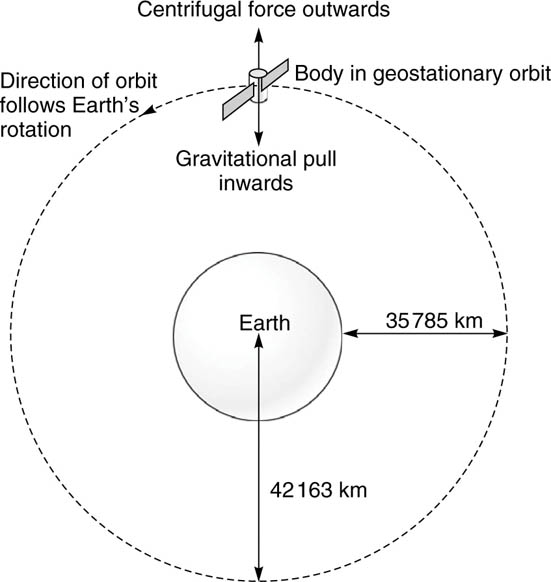Satellites and orbits
In October 1945, the famous science fiction author Arthur C. Clarke wrote an article which was published in a British radio hobbyist magazine. In that article, he put forward an idea about how the coverage of TV transmissions could be improved by using radio ‘relays’ situated above the Earth’s atmosphere. These relays are what we now call communications satellites.
The principle of the satellite is that it can be put into an orbit at a distance of about 35 000 km from the Earth’s surface so that as it orbits the Earth its speed of rotation exactly matches the speed of the Earth’s rotation. The effect of this is that the satellite appears stationary from any point on the Earth’s surface (geostationary) that can ‘see’ the satellite, and so antennas can be pointed in one direction and will always keep track of the satellite. If you have a satellite dish on your house for direct-to-home (DTH) satellite services, this is why it can be bolted down pointing in one direction, and it should never need to be moved again.
Geostationary orbit principles
The Earth completes one rotation on its North-South pole axis every 24 hours, and it can be calculated that at a specific distance from the Earth, a satellite in a circular orbit around the Earth will rotate at the same speed as the Earth. This will be essentially in an orbit where the centrifugal force of the satellite’s orbit, throwing the satellite out into space, is equal to the Earth’s gravity pulling the satellite towards the Earth.
Geostationary orbit

If the satellite’s orbit is directly above the Equator, then the satellite is said to be in a ‘geostationary’ orbit. The geostationary orbit is at a distance of 35 785 km above the Earth’s surface at any point on the Equator, and satellites that are positioned in this circular orbit above the Equator are said to be in the ‘geostationary arc’.
Currently, there are over 250 satellites in geostationary orbit, and in total over 8500 artificial satellites in various other types of orbits above the Earth, not only serving commercial telecommunications needs, but experimental, scientific observation, meteorological and military uses as well.
The position of a satellite within the geostationary arc is referred to by its longitudinal position relative to the Earth’s surface.
So let us just briefly look at the subject of longitude and latitude, since the co-ordinates of longitude and latitude are used when pinpointing the position of a satellite transmitter or receiver on the Earth’s surface. This is important for calculating the azimuth and elevation angles that are needed to correctly and accurately point the antenna at the satellite.
Longitude and latitude
Imagine that symmetrical lines run from the North to the South Poles – these are called lines of longitude (meridians), some of which are shown in the diagram overleaf. The line that runs through Greenwich in London, United Kingdom, is termed the Greenwich Meridian, and is the 0° longitude reference point. Lines run North to South around the complete 360° circumference of the Earth. Any point can be referred to as being at a certain point °E or °W of the Greenwich Meridian, depending on which direction around the Earth the point is being referenced. Satellite orbital positions in the geostationary arc are referred to in this way.
Similarly there are parallel lines that run in rings around the Earth from east to west between the North and the South Poles – these are lines of latitude or ‘parallels’. The line that runs around the Earth at its middle is the Equator, and is the 0° latitude reference point. Lines of latitude run from 0° to 90° running from the Equator to the North (Northern hemisphere), and similarly 0° to 90° from the Equator to the South (Southern hemisphere). Any point is referred to as being at a certain point °N or °S, depending on whether it is in the Northern or Southern hemisphere respectively.
Longitude and latitude

